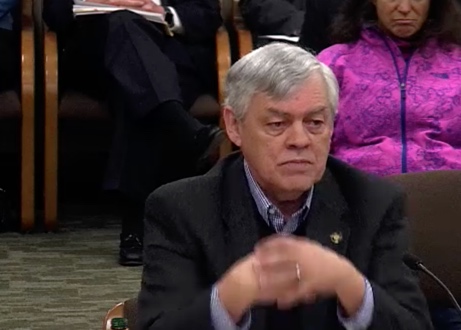
After months of speculation, legislators are finally sharing proposals that will eventually make up the statewide transportation funding bill.
Yesterday during a meeting of the Joint Committee on Transportation Preservation and Modernization, State Senator Lee Beyer (D-Springfield) laid out a proposal that would raise an additional $131 million a year for bicycling, walking, transit and street safety projects statewide.
Sen. Beyer, who led the workgroup and is co-chair of the committee, broke up the proposal into four sections: transit, safe routes to school, safety projects, and off-highway paths.
Here’s how it all breaks down.
Transit – $107 million a year
To increase the frequency, quality, and reach of the state’s 42 urban, rural and intercity transit systems, legislators want to create a Statewide Transit Improvement Fund. The fund would raise just over $107 million a year via a new employee payroll tax of one-tenth of one percent ($0.001).
The State of Oregon currently spends about $28 million a year on transit — which amounts to just 3.6 percent of the total spent statewide (local and federal sources make up 79 percent of the total). This significant increase would bump up the state’s share of transit funding to just over 15 percent. The new funds would be in addition to existing funds, meaning the state would have $135 million for transit each year. The proposal calls for allocating the money via a formula based on population. No local matching funds would be required to use this money.
There has been concerns aired in committee meetings and from advocates about how the new payroll tax would impact low-wage earners. Yesterday Sen. Beyer said they took that into account when making their proposal. He estimates the new tax would amount to 39-cents per week for someone who works 40-hours a week and makes the minimum wage of $9.75 per hour. “We asked Lane Transit District what it would take to expand service for frequency and reach and they said they’d have to raise fares and additional $2.40. This seems like a better way to do it,” Beyer said.
Drew Hagedorn of the Oregon Transit Association testified yesterday that the new fund would, “Raise the bar” and “could be transformational” for transit statewide.
— Read the details of the transit proposal here.
Safe Routes to School – $15 million per year
With $15 million a year, Sen. Beyer said his workgroup estimates they’ll be able to “Complete the safe routes within a quarter-mile of all elementary and middle schools in 10 years.” There are about 1,000 elementary and middle public schools in Oregon. With federal, state, and local funds, cities in Oregon currently spend about $40 million per year on safe routes to school projects. This new funding would bump up the annual investment to $55 million per year.
When Beyer proclaimed the funds would essentially “complete” a safe walking and biking network around schools in 10 years, committee member Representative John Lively (D-Springfield) reminded him that a wider radius is needed. “With all due respect senator, not all of us agree that ‘completing’ a safe routes to school network is a quarter-mile [around the school] since the transportation standars are that kids have to walk one mile in order to get there.” Lively was referring to Oregon state law that says school buses are only provided for students who live at least one-mile away from school. “While I appreciate what you say we can get done in 10 years,” Lively added, “That doesn’t necessarily mean we’ve created a true network of safe routes to school.”
“Representative,” Sen Beyer replied. “You’re right. This is what we can do. We can obviously do more if we’re willing to spend more.”
ODOT Assistant Director Travis Brouwer testified to the committee about the safe routes proposal. About the quarter-mile policy, he said, “Let’s at least get those close-in areas because that’s where the higher volume roads are.” “What we’d anticipate,” he continued, “Is that after we finish the quarter-mile in 10 years, we’d get to the next quarter-mile in the next 10 years, and so on.”
And advocates will ask them to do that. We’ve already heard concerns from safe routes advocates that they want to expand the radius of eligible projects to at least one mile around schools. Gerik Kransky, policy director for The Street Trust, said he’s also working with legislators to include specific provisions that the package would fund projects at Title 1 schools — where at least 40 percent of students are low-income and recieve free or reduced lunch.
“We’re going to push on that,” Kransky shared today. “We think the low-income communities are where these improvements are most needed.”
Another sticking point is that the proposal would only fund infrastructure. Safe routes to school experts says infrastructure alone won’t move the needle and that education and outreach are imperative. Kari Schlosshauer, the Pacific Northwest regional policy manager for the Safe Routes to School National Partnership, says her group is lobbying legislators to make sure the funding package includes money for programs. As we reported earlier this month, safe routes advocates have introduced House Bill 3230 as a way to influence future negotiations. Provisions in that bill would fund programs in addition to infrastructure.
Unlike the transit funding proposal, this safe routes money would require a 40 percent local match for larger cities. Projects would compete in a grant program administered by the Oregon Transportation Commission.
— Read details of the safe routes proposal here.
All Roads Transportation Safety program – $10 million per year
New funding for safety projects would go through ODOT’s existing All Roads Transportation Safety (ARTS) program to the tune of an additional $10 million per year. This program takes a data-driven approach to fixing danger spots for all road users — not just people on bike and on foot. It’s currently funded at $35 million per year.
The proposal on the table would use money from the state highway trust fund with the promise to “Address the 450 most dangerous safety issues on the state highway system within 10 years.”
Brouwer said ODOT operates under the assumption that every $1 million invested in safety saves one life — so we can expect a reduction of at least 10 fatalities over last year’s record number of 492 deaths if this proposal goes forward. In addition to biking and walking projects, this money would be spent on two motor-vehicle-specific categories (as defined by ODOT): “roadway departure crashes” and “crashes at intersections”.
— Read details of the safety proposal here.
Off-highway paths – $4 million per year
To “provide safe routes for bicycle and pedestrian commuters off the road network,” the proposal would raise $4 million in new revenue. That would be in addition to the $5 million (or so) the state currently doles out annually for path projects (through ConnectOregon and federal funding). The new funds would require a 50 percent local match and the OTC would need to draft project selection guidelines.
The state will look at two sources to raise this money: a new bicycle excise tax and a State Lottery funding program run by Oregon Parks and Recreation.
“We’ve heard loud and clear that they ought to pay their fair share,” Sen. Beyer said during his testimony yesterday in reference to the bike tax. “This doesn’t quite get there but we have a proposal for bicycle tax that raises about $2 million a year.”
Based on numbers shared by the State of Oregon, the tax would be about 4.5 percent on the purchase of a new bike. That equates to about $22 on a $500 bike.
Kransky with The Street Trust said they don’t support a bike tax, “But we’re going to wait and see the entire package before we commit to anything.”
— Read details of the path proposal here.
Proposal is likely to change
Keep in mind that this proposal is still considered to be “just concepts” at this point. Now the real horse-trading and sausage-making begins.
Also of note: this $131 million proposal is nearly identical to the amount for transit, biking and walking that was recommended in May 2016 by the Governor’s Transportation Vision Panel. It’s also $30 million lower than the $161 million that a coalition of transportation and environmental groups — including The Street Trust — are pushing for.
The number that comes forward for other categories like seismic upgrades, freeway expansion projects, rails/freight, and maintenance and preservation will likely dwarf the amount from the bike/walk/transit/safety workgroup. The challenge for legislators is to propose a large enough package to get the votes they need; but not so large that it seems greedy or impossible. Our hunch is that the total proposal will be around $850 million to $1 billion.
From here the Joint Committee will continue to hear presentations from other workgroups (the “congestion relief” report is due on Monday 3/27). Then they have a meeting to discuss how exactly they’ll raise the revenue.
Stay tuned.
— Jonathan Maus: (503) 706-8804, @jonathan_maus on Twitter and jonathan@bikeportland.org
BikePortland is supported by the community (that means you!). Please become a subscriber or make a donation today.


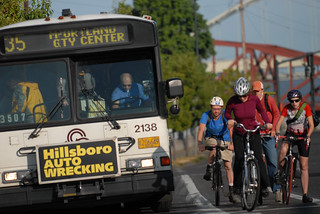
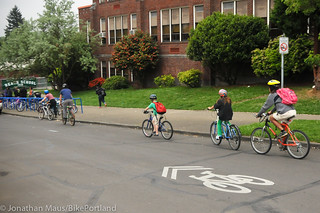
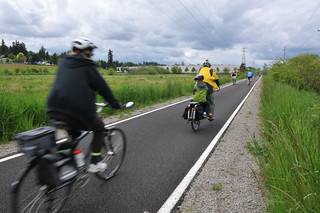
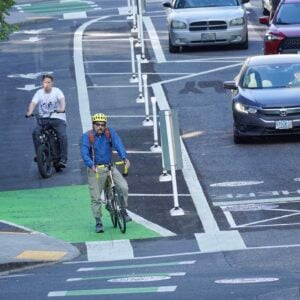



Thanks for reading.
BikePortland has served this community with independent community journalism since 2005. We rely on subscriptions from readers like you to survive. Your financial support is vital in keeping this valuable resource alive and well.
Please subscribe today to strengthen and expand our work.
Oh, that “bikers don’t pay their fair share” argument again.
I find the idea of a bicycle tax utterly infuriating and hope that the Street Trust and others fight it tooth and nail. Why policymakers would want to raise barriers to entry for people wanting to get out of their car is beyond me.
***Hi 9watts.. Jonathan here … I’m deleting this whole thread between you and Smokey Bear because it’s completely off-topic and doesn’t add anything to the thread. Sorry. Hope you understand.
Yeah, JM, I get it. Videos of Hillary, Bernie, Bill C, etc admitting there were wmd is too hot to handle. Add to that video of Obama and Michelle both admitting he was born in Kenya was absolutely explosive. We get it. 🙂
More taxes to support the unsustainable, bankrupt PERS system. Not one cent will go to anything except PERS pensions.
Not by anyone who actually rides a bicycle, I suspect.
$15M/yr x 10 yr = $150M won’t do much for Safe Routes. Most of Portland’s elementary schools could easily each spend $3-$5M. There are about 90 schools (all levels) in Portland, so just in Portland the need is $270-$450M.
Indeed. Also this “after we finish the quarter-mile in 10 years, we’d get to the next quarter-mile in the next 10 years…”
Umm, the area covered by the second 1/4-mile radius is 3 times the area in the first 1/4-mile radius. #math
Oops, didn’t see David’s comment to the same effect below.
It’s good to see other people value math as well and understand quickly when someone is just saying things to gloss over a larger issue.
“Most of Portland’s elementary schools could easily each spend $3-$5M. There are about 90 schools (all levels) in Portland, so just in Portland the need is $270-$450M.”
I guess I don’t quite follow. Wouldn’t lowering speed limits (and actually enforcing them) around schools be a whole lot cheaper and quicker? A quarter mile is five blocks… I’m not really seeing how one could spend a few million for upgrading a short hop like that.
Most of the money goes to “education” programs.
You know, for kids.
Nope.
Take a look at the last ten or fifteen Safe Routes reports. $3-5 M per school, just infrastructure. Parklane-Oliver was the last one completed.
https://www.portlandoregon.gov/transportation/article/536565
Since when does Oliver have any cycling infra nearby? Did PBOT make 162nd somehow not deadly for kids to cross?
Um, I think paikiala was saying that the *report* was complete, not the recommended changes.
This is an interesting set of proposals. It’s concerning that ODOT representatives don’t understand basic geometry (the area of a circle increases exponentially as the radius increases, so the same amount of funding and time will not allow for the 2nd 1/4 mile for SRTS to be completed as easily as the first 1/4 mile) leading to quotes like “What we’d anticipate,” he continued, “Is that after we finish the quarter-mile in 10 years, we’d get to the next quarter-mile in the next 10 years, and so on.”
The ARTS program sounds nice though it would be even better with a focus on vulnerable road users moving some of that money to the local level instead of trusting ODOT.
Undoubtedly the best part of this whole article was the line about the “congestion relief” workgroup because getting people to take transit or bike more is obviously not as cost effective as building some new highway lanes. They could provide congestion relief for a fraction of $850 million by funding better transit even above the proposed levels and actually filling out something resembling a bike network (in Portland, since that’s where the highway building is set to happen) so that people don’t feel that taking the car out of the driveway is the only viable option for most trips.
I was excited until i realized how little bikes were getting out of this. We need to shake the money tree harder
Safe routes to schools? ODOT would never put up with the concept. there is no school zone around Cleveland HS. Just a wide open thoroughfare where the bike paths are being removed.
Yes–this confuses me. Does Safe Routes to Schools not include high schools? And if so, why not?
School 20 mph zones are uncommon around high schools in Portland.
Portland has not yet expanded into high schools to any great extent, instead focusing behavior change on younger viewers.
The PPS effort to identify safe routes centers on HS clusters to identify future projects.
Jesuit has a 20 mph zone on ODOT’s BH Highway. The flashing lights operate during certain school hours.
Re: Safe Routes to School: “after we finish the quarter-mile in 10 years, we’d get to the next quarter-mile in the next 10 years”
Whoah, geometry lesson! 1/4 radius is less than 1/4 square mile of area. A 1/2 radius is almost 1 square mile: 4 times as much area, and therefore 4 times as many miles of streets that need improvements!
For the simplest example, consider a school at the corner of 2 arterial streets, with no side streets. With a 1/4 mile radius you have 1 mile of streets to improve (1/2 mile east-west and 1/2 mile north-south). With a 1/2 mile radius you now need to improve 4 miles of streets: and additional 3 miles.
To get that extra 1/4 mile will take 30 years, not 10 years, or it will need 3 times as much funding as the first 10 years. Big difference!
I’m disturbed that Brouwer from the ODOT is ignoring this basic geometric reality.
Since when do highway engineers need to know basic math??
“… and actually filling out something resembling a bike network (in Portland, …” joe e
How many people in Portland, really have the vision for something like that? It’s an extraordinary concept for this town. Would take a lot of commitment to build a good one.
On the concept of safe routes to school: …last Tuesday on opb, I saw the show ‘Slow Walk Home’. I don’t think it’s a new show…some of you may have seen it last year. It details the contrast between Japan and the U.S. views on school kids getting to and from school. Amazing statistic cited right up front as the show starts: …something like 95 percent of Japanese kids walk to school, every day. The show commentary says Japan committed to this idea, starting in 1952.
I don’t remember well, the stats given for U.S. school kids walking to school, but it’s a small percentage. The show included some overhead pics of a couple U.S. schools, explaining that the l-o-o-ong driveways leading up to school, was for parents to queue up in their cars off street as they inched along to where they would pick their kids up, directly across the entrance to the school.
Doesn’t appear that opb will soon be rebroadcasting the show. No info really on the page I’m providing the link for, but maybe it’ll be of some help:
http://www.opb.org/television/programs/slow-way-home/
Portland does better than the national average:
https://www.portlandoregon.gov/transportation/68016
Being a tall midget still leaves you a midget. Perhaps we should be aiming a bit higher than Nebraska, Mississippi and Alabama.
No sales tax for bikes until there is a sales tax for trucks, motorcycles, cars, motor vehicle parts etc etc etc.
If we want a sales tax, do it as a state-wide system, or better yet a VAT that taxes all consumption. It makes no sense to target bikes for a one-off sales tax, with all the red tape and administrative costs for such a small tax.
Cars already pay a gasoline tax, emissions tax, recycle tax when some parts are replaced, license tax, etc. And trucks pay big league taxes based on weight and mileage, etc.
😉
Not enough to cover the externalities. Not even CLOSE.
I do agree that we don’t need a bike tax. We need some folks with gray stuff between their ears who can cut the wasteful spending; do all that needs to be done with the money they have, and end up with a big pile left over. It would not be hard to do, but the key is the gray stuff.
😉
By wasteful spending, you mean all highway expansion projects, right?
No, all wasteful spending in all government departments. Government programs, once created, are rarely cut back even when they are no longer needed. And many things government spends money on just don’t need to be done at all by anyone, ever. The last 2-year budget was 69 billion. Anyone could find 10% waste in that with little effort.
https://www.oregonlegislature.gov/lfo/Documents/2015-1-LAB-Summary15-17.pdf
Sure, let’s cut back military funding then. It’s the largest portion of the national budget. Anyone can see that we spend too much on “defense” with little effort, right?
I suspect we could find some waste in the military. The military is a legitimate expense, unlike a whole lot of other things done by governments at all levels. We need a strong military because we live in a dangerous world, but yeah, I’d find some waste to cut.
In your example, we should be able to easily cut 10% from “public safety”. Surely the PPB would be willing to part with a few cases of crowd-control grenades and chemical weapons to pay for safer streets, right?
First thing I’d cut would be overtime and unreasonably generous pensions and benefits. Probably a lot of useless touchy/feely positions that could be cut as well. And maybe I’d pass some laws that give citizens better tools to protect themselves better and not be afraid to do it.
China’s version of active transport…
https://www.theguardian.com/cities/2017/mar/22/bike-wars-dockless-china-millions-bicycles-hangzhou
WOW! It says there are so many non-working bikes around that they have ruined the beauty of the city! Sounds like someone is trying to bury them in bikes. 🙂
People using damaging metal-studded tires on cars ought to pay a giant fee !
I’d be in favor of a reasonable fee – say $10 or $20 tacked on when you buy a set of studded tires – because they do cause damage – I think they are why we have ruts in our freeways.
Does Lee Beyer want a fee or ban on metal-studded tires for cars?